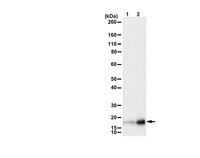ABE2854-100UL Sigma-AldrichAnti-Histone H3K27butyrl
Anti-Histone H3K27butyrl, Cat. No. ABE2854, is a rabbit polyclonal antibody that detects Histone H3 butyrlated on lysine 27 and is tested for use in Chromatin Immunoprecipitation, Dot Blot, Immunofluorescence, and Western Blotting.
More>> Anti-Histone H3K27butyrl, Cat. No. ABE2854, is a rabbit polyclonal antibody that detects Histone H3 butyrlated on lysine 27 and is tested for use in Chromatin Immunoprecipitation, Dot Blot, Immunofluorescence, and Western Blotting. Less<<Recommended Products
Overview
| Replacement Information |
|---|
| References |
|---|
| Product Information | |
|---|---|
| Format | Purified |
| Presentation | Purified rabbit polyclonal antibody in buffer containing 0.1 M Tris-Glycine (pH 7.4), 150 mM NaCl with 0.05% sodium azide. |
| Quality Level | MQ200 |
| Physicochemical Information |
|---|
| Dimensions |
|---|
| Materials Information |
|---|
| Toxicological Information |
|---|
| Safety Information according to GHS |
|---|
| Safety Information |
|---|
| Storage and Shipping Information | |
|---|---|
| Storage Conditions | Recommended storage: +2°C to +8°C. |
| Packaging Information | |
|---|---|
| Material Size | 100 µL |
| Transport Information |
|---|
| Supplemental Information |
|---|
| Specifications |
|---|
| Global Trade Item Number | |
|---|---|
| Catalog Number | GTIN |
| ABE2854-100UL | 04065269367796 |
Documentation
Anti-Histone H3K27butyrl SDS
| Title |
|---|
Anti-Histone H3K27butyrl Certificates of Analysis
| Title | Lot Number |
|---|---|
| Anti-Histone H3K27butyrl - Q4025589 | Q4025589 |
















